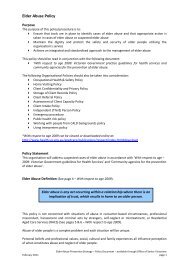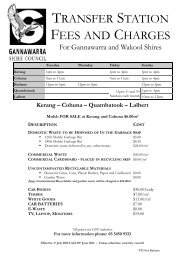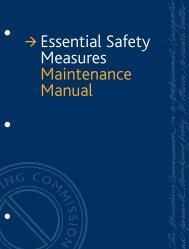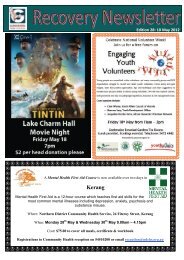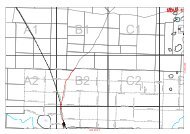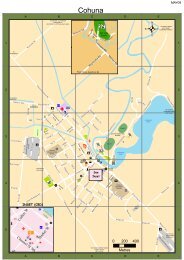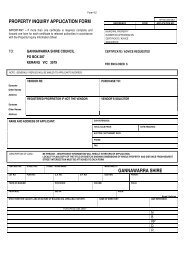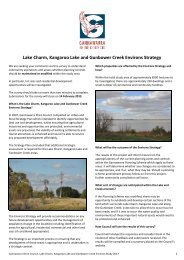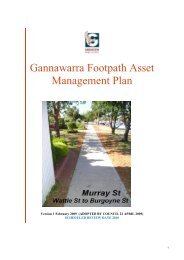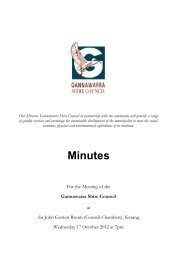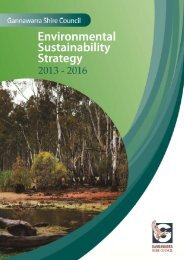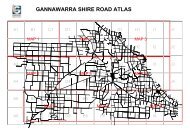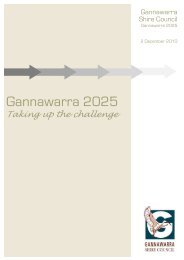Gannawarra Shire Heritage Study Stage One Volume One Thematic ...
Gannawarra Shire Heritage Study Stage One Volume One Thematic ...
Gannawarra Shire Heritage Study Stage One Volume One Thematic ...
You also want an ePaper? Increase the reach of your titles
YUMPU automatically turns print PDFs into web optimized ePapers that Google loves.
‘wild-dog’ fence was erected in 1883 from the South Australia border to a point near Lalbert and then north to<br />
the Murray River. In the same year under the Mallee Pastoral Leases Act, the Mallee was divided into ‘fringe’<br />
and ‘interior’ sectors. In the ‘fringe’ sector, allotments of between five hundred and 1200 acres extending to<br />
20,000 acres were offered. In the ‘interior’, land was divided into ‘A’ and ‘B’ blocks ranging from sixty to<br />
over five hundred square miles. ‘A’ blocks fronted all available water sources and were able to be taken up on<br />
twenty-year leases. ‘B’ blocks were available on five-year leases. In addition, compensation for vermin<br />
control was to be paid at the expiration of the lease. The Bael Bael run was subdivided and taken up for wheat<br />
growing from 1893. 34<br />
The Australasian summed up these early years in the Mallee:<br />
The first years of Mallee settlement were characterised by keen struggle, want of capital, ‘scratch’<br />
methods of farming and occasional despondency. The support - moral and financial - of the business<br />
and commercial community, as well as the State, should be accorded to those who, by their efforts,<br />
were attempting to transform a barren wilderness into fertile fields of grain. 35<br />
Those able to endure these hardships experienced more favourable conditions in ensuing years, however for<br />
many, inadequate acreages, lack of capital necessary for clearing, fencing, building, and the purchase of<br />
machinery, plus a surplus of wheat on the world market meant that many settlers either defaulted on their rates<br />
or simply walked off the land. Spurred on by the construction of the railway from Kerang to Swan Hill, others<br />
made quick profits through land speculation and subdivision. By 1902, the Mallee fringe had been settled as<br />
far as the existing railways extended.<br />
The difficulties endured by settlers in taking up land under the Mallee Pastoral Leases Act was<br />
recognised by another Act in 1889 passed to allow the alienation of an additional 320 acres as an Agricultural<br />
Allotment. In 1896, the Mallee Lands Act increased selection of land to the maximum of 640 acres available<br />
either as an Agricultural Allotment or perpetual lease payable over forty years. Other changes to the Act were<br />
made in 1898, 1900 and 1903. Land Acts in 1901, 1911 and 1915 saw the dividing up of Mallee Pastoral<br />
Leases upon their expiration.<br />
The selection landscape<br />
The first selectors built homes of locally available materials. Dwellings consisted of crude log cabins<br />
made windproof with clay, hessian-lined drop log cabins, wattle and daub constructions, and mud brick<br />
buildings. In the Mallee, sleeping quarters were often constructed underground and later converted to cellars.<br />
By the turn of the century, new building materials were available. Internal linings were available in cardboard,<br />
pressed steel (Wunderlich), pine boarding and sheet plaster.<br />
Settlers in the Mallee were faced with the prospect of clearing mallee vegetation. It could not be<br />
merely felled and burnt as its massive stumps produced new growth within a year or so. Each stump, with its<br />
large root system, needed to be grubbed. This proved a slow, difficult and expensive task. The technology to<br />
34 "Mallee Area Review." Melbourne: Land Conservation Council, 1987, 38.<br />
35 Australasian, 18 November, 1916<br />
<strong>Gannawarra</strong> <strong>Shire</strong> <strong>Heritage</strong> <strong>Study</strong> <strong>Stage</strong> <strong>One</strong> <strong>Volume</strong> <strong>One</strong> <strong>Thematic</strong> Environmental History<br />
Robyn Ballinger (History in the Making) December 2008<br />
16



